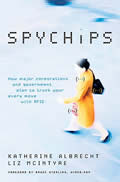Other
Dean
Articles:
MISTLETOE - THE HERB FOR ALL SEASONS
Dr.
Carolyn Dean, MD, ND and
Elissa Meininger
December 22, 2005
NewsWithViews.com
When most of us conjure up images of Christmas, we see glimpses of it in stories told by Charles Dickens, considered the creator of modern Christmas. We see grand manor houses festooned, that�s right, festooned, with brightly lit Christmas trees, boughs of holly, mistletoe, colorful poinsettias, and amaryllis as well as banquet tables groaning from the weight of all manner of sumptuous food and drink made traditionally to mark this special season.
Few of us realize, however, that Dickens drew his images of Christmas from the literary works of American writer Washington Irving who toured Europe and wrote of lavish banquets in his 1822 work, �Bracebridge Hall�. It was here Irving alluded to the ancient custom of stealing a kiss under the mistletoe. Dickens later wrote about this custom in his 1837 book, �Pickwick Papers�.
However, the mistletoe custom and appreciation of its magical powers go back much further to the Greeks, who used it in marriage rights because they believed it was the giver of life and fertility. In Scandinavia, mistletoe was considered a plant of peace, under which enemies could declare a truce or warring married couples could kiss and make up. In early England, the Druids used it in ceremonies to promote prosperity and from the Middle Ages forward it was used to ward off evil spirits. In fact, the name �mistletoe� in the Druid language means �all-healing� and in those earlier times, in Europe and Asia, it was also used for all manner of illnesses including treating rapid heart rates, high blood pressure, and even epilepsy.
It wasn�t until the 1800s, during the time Irving and Dickens were creating wonderful images of Merry Old England and Christmas cheer (to brighten up the drab lives of their readers), that the mistletoe kissing ball became an official part of the festivities surrounding the celebration of Christmas.
As late as 2001, we Americans had no idea that mistletoe had any healing powers until TV actress, Suzanne Somers reported that she used it as part of her protocol to treat breast cancer. She had her tumor removed and used radiation but opted to avoid chemotherapy and used Iscador, a mistletoe extract, instead, injecting a small amount into her abdomen every day. During this time, she appeared on the Larry King Live show to talk about her experience. Once the story broke, the headlines that followed painted mistletoe therapy as some sort of bizarre, whacko, unproven, irresponsible, and dangerous treatment. Even though they knew nothing about it and had no experience with it, some of those who went on record to bash mistletoe were prominent members of modern medicine�s cancer treatment industry. They also painted Suzanne as a loony, probably to make sure no one followed in her footsteps. However, those of us who advocate natural health modalities have no difficulty understanding why Suzanne made her decision to avoid chemotherapy and choose something both safe and effective.
In reality, mistletoe therapy for cancer was developed in the 1920s. Iscador is the leading cancer treatment in Germany and utilized by half the doctors in that country. Meanwhile the Swiss have bragging rights to the Lukas Clinic, a full-fledged, world-class hospital specializing in cancer treatment using mistletoe as a mainstay for 80 years. Mistletoe therapies are available in other parts of the world as well and some are used to treat a number of maladies other than cancer. And, if you know where to find them, there are Iscador and Iscar treatment experts here in the US. (Iscar is the homeopathic form of Iscador.)
There are several types of mistletoe: some have no medicinal properties and of the medicinal varieties, Viscum album � European mistletoe, is the most well known. What makes mistletoe particularly intriguing as a potential cancer medicinal is the fact that some grow as semi-parasites, drawing water and minerals from their host �much like the cancer they are destined to treat. Mistletoe bushes grow on the branches of trees such as oak, apple, elm, pine, birch and maple.
Back in the 1920s, developers of mistletoe cancer medicinals viewed cancer as a parasite living on a human body, and were drawn to mistletoe. Many natural healing arts experts have a rule of thumb philosophy that �like cures like� and in this case, mistletoe sure fit the bill as functioning somewhat like cancer on its host. Interestingly, over the years, mistletoe experts have learned that the quality and concentration of the healing ingredients of the medicinal is determined by the type of tree it is living off and what time of year the mistletoe is harvested. Doctors then are able to match the actual healing properties of the end product with the exact needs of each patient. This individualized care is common in the natural healing arts and drives its product development and use.
While the American press had a field day condemning Suzanne Somers� use of mistletoe, they ignored a major study published by sociologist Dr. Ronald Grossarth-Maticek. He followed 35,000 people in Germany for 27 years reaching the conclusion that use of mistletoe, and Iscador in particular, could prolong life by 40%.
This study is available in English and makes interesting reading. [Read]
It is important to note that mistletoe as a cancer treatment is often used in conjunction with modern medical treatments �perhaps the best of both worlds. Mistletoe has a quality to help the patient bolster his or her immune system in such a way that whatever else is being used, these other, often highly toxic or aggressive treatments, can be better tolerated.
|
Subscribe to the NewsWithViews Daily News Alerts! |
If you or someone you know is interested in seeking mistletoe therapy, you may want to contact the Lukas Clinic directly, or checkout the other websites below. They are all loaded with technical information covering all aspects of the magic of mistletoe in healing not just people with cancer, but other serious maladies as well. Above all, Elissa and I urge you to hang mistletoe this year and enjoy its social benefits and have a very happy holiday.
Related Sites:
1,
www.lukasklinik.ch/
2, www.iscador.com/
3, http://usa.weleda.com/
ACT
FOR HEALTH FREEDOM NOW:
Go to www.friendsoffreedominternational.org
view and purchase the new movie on Codex and Free Trade called "We
Become Silent" by Kevin Miller
Also purchase "Death
by Modern Medicine." Proceeds from the sale of these products
are crucial to help us fund our health freedom action. For state action
go to: www.nationalhealthfreedom.org.
� 2005 Carolyn Dean -
All Rights Reserved
Dr. Carolyn Dean is a medical doctor, naturopathic doctor, herbalist, acupuncturist, nutritionist, as well as a powerful health activist fighting for health freedom as president of Friends of Freedom International. Dr. Dean is the author of over a dozen health books, the latest of which is "Death By Modern Medicine".
Elissa Meininger, is Vice President of Friends of Freedom International and co-founder of the Health Freedom Action Network, a grassroots citizens' political action group. She is also a health freedom political analyst and can be heard on the natural health radio show SuperHealth, broadcast weekly on station WKY (SuperTalk AM 930) in Oklahoma City.
Website:
www.deathbymodernmedicine.com
Website: www.carolyndean.com
E-Mail: holeopharm@pol.net
It is important to note that mistletoe as a cancer treatment is often
used in conjunction with modern medical treatments �perhaps the best of
both worlds.










